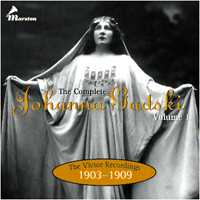
|
The
Complete Johanna Gadski: Volume 1 |
|
|
|
|

A Note From Ward Marston
The year was 1903 and the fledgling Victor Talking Machine Company, which had hitherto only dabbled in recording serious music, inaugurated its now famous Red Seal celebrity series. The initial release comprised recordings by such notable singers as Emma Calvé, Maurice Renaud, Pol Plançon, and the young tenor Enrico Caruso, all imported from the Gramophone and Typewriter Company, Ltd. Soon after, Victor released its own recordings by Ada Crossley, Zélie de Lussan, Giuseppe Campanari, Louise Homer, Pol Plançon, Antonio Scotti, and Johanna Gadski.
Gadski's 1903 Red Seal discs, all recorded with piano accompaniment, possess a remarkable sonic presence. The sound on these discs is forward and vibrant, with the acoustics of the room clearly audible. Considering the immensity of Gadski's voice and the primitive recording equipment of the day, these discs are nothing short of miraculous. When played with the heavy tone arms of the period however, these very loud recordings tended to deteriorate rapidly, and few pristine, unworn copies ever surface today. I am most fortunate to have at my disposal marvelous examples of Gadski's early discs except her first recording of "O patria mia" from Aïda. Recorded in November 1903, this disc was withdrawn from circulation within several months and immediately replaced by a new recording of the same aria cut in March of the following year. This may have been due to the fact that the first take was recorded at such a high level that it could withstand only a few playings before wearing out. Other records from 1903 by Louise Homer and Pol Plançon were similarly withdrawn. There is also a possible musical explanation for the sudden demise of Gadski's first take of the Aïda solo. During the introduction, the pianist makes two rather jolting mistakes, and toward the end of the aria, Gadski seems unsure of the words following her climactic high C. Perhaps, Gadski herself may have requested that the recording be withdrawn. In any case, this is certainly her rarest record, and this collector has only ever seen the one copy remastered here. The disc is somewhat worn, and it is impossible to eliminate the blasting that occurs during Gadski's loudest notes, but every effort has been made to make this disc listenable.
Over the next five years, the Victor company reduced the sound level of its recordings in order to prevent their discs from wearing too quickly. Notice, for example, how faint Gadski's 1908 lieder recordings are, compared with the group from 1903/04. The reduction of the sound level was at the expense of sonic splendor; for never again, during the acoustic recording era, did Victor produce anything to compare with the brilliance of the 1903-04 Red Seal discs.
Finally, there is a fascinating point to be made concerning the two takes of the quintet from Die Meistersinger presented here. Three takes were recorded on 29 January 1908, but only takes one and two were saved. Neither take is a musical triumph for Johanna Gadski but she is certainly satisfactory. The first take actually becomes a musical disaster however, due to the careless mis-counting of bass Marcel Journet. The music is in 6/8 meter and counting Gadski's solo entrance as bar one, the problem begins during bar twenty-seven (CD2, Track 9, 2:12). Journet is supposed to sing three beats of E-flat, then three beats of E-double flat, followed by three beats of C-flat, beginning bar twenty-eight. Instead, he sings two beats of E-flat, one beat of E-double flat, followed by three beats of C-flat, which places him three beats ahead of the rest of the ensemble. He makes no attempt to find his place during subsequent bars, and remains ahead of the rest until, near the end of the performance, they all somehow find each other. To me, it is amazing that this take didn't just come to a grinding halt. What is even more amazing is that this take was chosen for publication over take two, which is perfectly adequate. Perhaps we will never know who made the decision and why, but at least we should feel fortunate to have both takes for comparison.
© Ward Marston, 1997